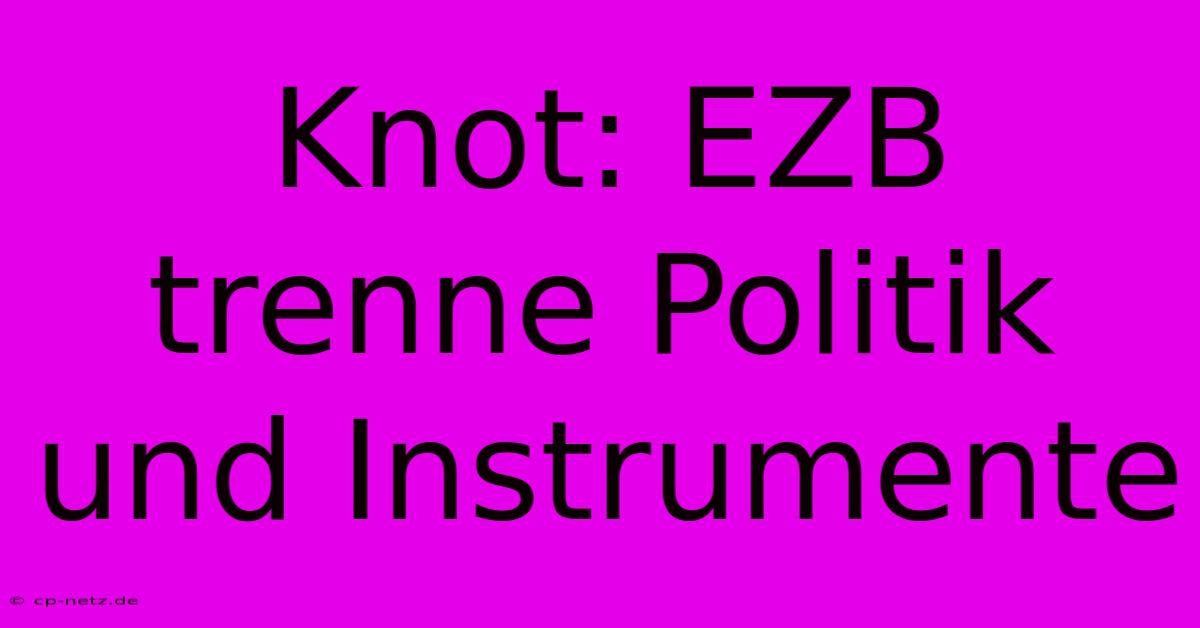Knot: EZB Trenne Politik Und Instrumente

Discover more detailed and exciting information on our website. Click the link below to start your adventure: Visit Best Website Knot: EZB Trenne Politik Und Instrumente. Don't miss out!
Table of Contents
Knot: EZB trenne Politik und Instrumente – Ein Blogbeitrag
Hey Leute! Let's talk about something that's been on my mind lately: the European Central Bank (EZB) and how they handle their monetary policy. Specifically, I want to dive into the idea of separating the policy from the instruments they use – something that's been buzzing around lately, particularly with this whole "Knot" thing. Honestly, I'm still trying to wrap my head around all the complexities, but I'll share my thoughts and what I've learned so far.
What's the Big Deal with "Knot"?
So, "Knot" – it's not exactly a household name, right? But in the world of monetary policy, it's causing some serious waves. Basically, it refers to a proposal (or maybe a growing movement?) to restructure how the EZB operates. The core idea? Separate the decision-making on what the EZB wants to achieve (the policy goals, like inflation targets) from the how – the specific tools they use to reach those goals (like interest rates, quantitative easing, etc.).
I remember when I first heard about this – total information overload! My initial reaction was "Huh?". It sounded like some super complicated academic debate. But the more I dug in, the more I realized it could have some serious implications. It's not just some abstract economic theory. This could impact our everyday lives, affecting everything from our mortgages to the price of groceries.
Why Separate Policy and Instruments?
Think of it like this: you want to bake a cake (the policy goal – a delicious cake!). You could use a recipe (a specific set of instruments), but maybe that recipe isn't perfect for your oven or the ingredients you have. Separating policy and instruments allows for more flexibility. If the initial tools aren't working, you can switch them up without changing your core goal (still a delicious cake!).
With the EZB, this separation could mean better responses to unexpected economic shocks – like, say, a sudden energy crisis. By separating the "what" from the "how," the EZB could potentially be more nimble, adapting its approach based on real-time data and circumstances. This could lead to more effective monetary policy. That's the theory, at least.
But, here's the thing. It's not that simple. I mean, this involves some really complex financial models and stuff. It also gets super political. Different countries within the Eurozone have varying economic priorities, and these discussions can get... messy.
Potential Challenges and My Concerns
One of my biggest worries? The potential for conflicts of interest. If you're separate departments in charge of policies and instruments, who is ultimately accountable? What if they disagree? This lack of integration could lead to communication problems, inefficiency, and even worse, policy errors. It’s important to have someone or a group of people who take ownership and responsibility.
Another thing that keeps me up at night is the communication aspect. How will the EZB ensure transparency and public understanding if these two things are managed separately? Clear and concise communication about monetary policy is crucial for public trust and stability.
The Bottom Line: Still Lots to Learn
This whole "Knot" thing is super complex, and honestly, I still have a lot to learn. But it's a crucial discussion with implications for all of us. We need to follow these developments closely and encourage open discussion about the tradeoffs involved in separating policy and instruments. What do you think? Let me know in the comments – let's have a conversation.
Keywords: EZB, European Central Bank, Monetary Policy, Knot, Inflation, Interest Rates, Quantitative Easing, Economic Policy, Eurozone, Policy Instruments.

Thank you for visiting our website wich cover about Knot: EZB Trenne Politik Und Instrumente. We hope the information provided has been useful to you. Feel free to contact us if you have any questions or need further assistance. See you next time and dont miss to bookmark.
Featured Posts
-
Biden Rechtliche Zulaessigkeit Der Begnadigung
Dec 03, 2024
-
Jimi Blue Ochsenknecht Aerger Mit Der Staatsanwaltschaft
Dec 03, 2024
-
Sammlung Verkauft Ecclestones Rennwagen
Dec 03, 2024
-
Zuerichs Klima Flugreisen 2024
Dec 03, 2024
-
Tencent Aktienkurs Erholt Sich Montag
Dec 03, 2024
